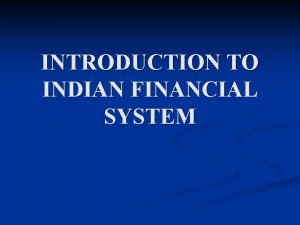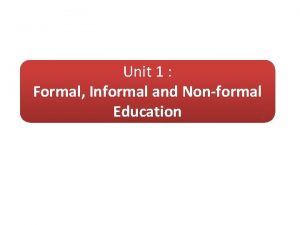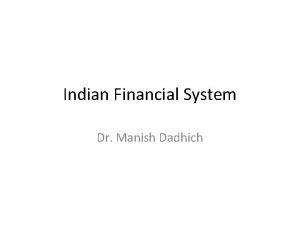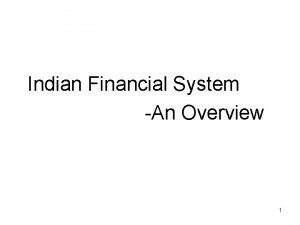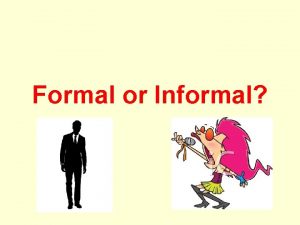INTRODUCTION TO INDIAN FINANCIAL SYSTEM FORMAL AND INFORMAL









- Slides: 9

INTRODUCTION TO INDIAN FINANCIAL SYSTEM

FORMAL AND INFORMAL FINANCIAL SECTOR n Formal financial sector is characterized by the presence of an organized, institutional and regulated system. n Informal financial sector is an unorganized , non- institutional, and non- regulated system dealing with the traditional and rural spheres of the economy.

Components of the Formal Financial System Financial Institutions n Financial Markets n Financial Instruments n Financial Services n

Financial Institutions n Banking Institutions: Participate in the economy's payment mechanism, deposit liabilities constitute a major part of national money supply. n Non-Banking Institutions: LIC, SIDBI, IIBI, IFCI ( All India Financial Institutions), SFCs & SIDCs

Financial Markets n Primary ( Direct) Market or New Issue Market: Dealing in the new financial claims or new securities. n Secondary Market: Dealing in the securities already issued or existing or outstanding.

Financial Markets n Money Markets: Highly liquid short term debt – instruments market including Call Money Market, Certificates of Deposits, Commercial Papers and Treasury Bills. n Capital Markets: Market for Long-Term securities and provides risky capital in the form of equity.

Financial Instruments n Primary Securities: Equity, Preference, Debt and Various combinations. n Secondary Securities: Mutual Fund Units and Insurance Policies etc.

Financial Services Depositories n Custodial n Credit Rating n Leasing n Portfolio Management n Underwriting etc. n

Functions of the Financial system To link the savers & investors. n To inspire the operators to monitor the performance of the investment. n To achieve optimum allocation of risk bearing. n It makes available price - related information. n It helps in promoting the process of financial deepening and broadening n
 Registro formal e informal ejemplos
Registro formal e informal ejemplos Informal financial system
Informal financial system Unit 3 formal informal and nonformal education
Unit 3 formal informal and nonformal education Constituents of indian financial system
Constituents of indian financial system Regulatory institutions in indian financial system
Regulatory institutions in indian financial system Evolution of indian financial system
Evolution of indian financial system Components of indian financial system
Components of indian financial system Indian and international place value chart
Indian and international place value chart Strengths and weaknesses of formal assessments
Strengths and weaknesses of formal assessments How do informational reports and analytical reports differ
How do informational reports and analytical reports differ

